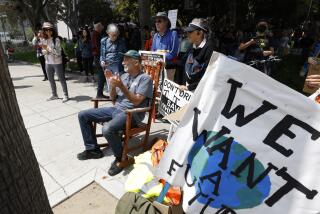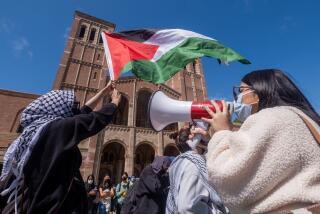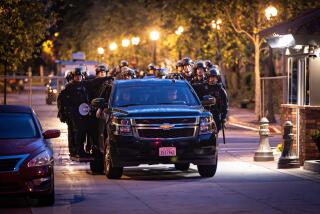National Agenda : Youths Stand Up and Fight--and Grasp the Soviet Future : * And by doing so, they could give a powerful new thrust to the country’s reform movement.
MOSCOW — As tanks and armored personnel carriers closed in on the Russian Parliament late Tuesday night, 16-year-old Misha Podnakov was among thousands of young people standing arm-in-arm, ready to sacrifice their lives to resist dictatorship.
“We thought there would be a storm any minute,” Podnakov said, remembering the emotion at the barricades as portable radios brought the news to the protesters that soldiers had been ordered to attack the Parliament. “There was incredible tension in the air. But none of us even considered running away. We knew that our futures depended on our resistance.”
Three men died in the violence that night, but the bloodshed only intensified the resolve of the thousands of young people who held a vigil outside the enormous white Parliament building to protect Russian Federation President Boris N. Yeltsin and his government.
In their resistance to the attempted coup, the teen-agers and young adults of Russia--who had been conspicuously absent from the emergent democratic reform movement until last week--suddenly became one of the most influential factors in the battle for Soviet freedom.
Assuming that they stay politically engaged, these young people could give a powerful new thrust to the movement. And ultimately young new faces may appear in Russian or Soviet leadership lineups that have for more than seven decades been dominated by old or at best middle-aged men.
The new Soviet Defense Minister, Col. Gen. Yevgeny I. Shaposhnikov, said Sunday he plans to shake up 80% of the country’s military leadership, with special emphasis on appointing people who are “younger, more loyal and incapable of anti-constitutional acts.”
During a speech to mourners of the victims of the putsch, Yeltsin, choking back emotion, said he was especially grateful to the youth: “The young people were the first to stand up in defense of freedom and the independence of Russia.”
During the crisis last week, one after another, the young people emerged as heroes of the people’s resistance.
* Soon after the coup started, a student movement sprang into action--frantically telephoning student leaders at 20 universities and institutes and telling them to immediately spread the news that everyone should go to the Parliament and protect the first president Russia has ever elected.
* Just hours after being ordered to Moscow, a 23-year-old tank commander talked personally with Yeltsin and then persuaded his superior officer to break ranks by setting up their armor in defense of the Russian Parliament. They were the first of thousands of Soviet soldiers to pledge their support to Yeltsin and denounce the hard-line gang trying to overthrow their government.
* The majority of the people who built massive barricades out of concrete blocks, bricks, scrap metal and anything else available were in their teens or 20s. And these same volunteers--young men dressed in mismatched military fatigues, “Soviet hippies” with long hair and worn-out jeans and young women in mini-skirts and stiletto heels--also manned human barricades.
* Two of the three new state heroes buried over the weekend, who lost their lives trying to stop armored vehicles backing the coup, were young men who had recently finished their military service and were just starting their careers.
“In all the mass actions, the young people played a very big role,” Vladimir Boxer, a grass-roots organizer for Democratic Russia, the most powerful democratic movement in the Russian Federattion, said. “For many people this was a surprise. . . .
“An especially important part was played by the Inter-University Union of cells of Democratic Russia, which includes more than 20 universities and institutes, which called up the student activists.”
Many of the leaders of volunteer defense groups at the Russian Parliament were young businessmen who saw that they stood to lose everything if the coup were successful.
Vladimir Nikiforov, 24, the manager of a private business that runs restaurants, bars and beauty shops, said he and many of the 100 volunteers he managed had left their businesses unmanned and headed to the Parliament because they saw no other way to protect their futures.
“Our job is to keep order, make sure there’s no panic, bring more people out here and, in general, to get prepared,” said Nikiforov, who was dressed in German hiking boots and his father’s old Soviet military uniform complete with flowing cape. “We are ready for anything. We’ve had enough of living under Communists and we want to live like normal people.”
Whereas at most pro-democracy demonstrations over the last three years the percentage of people under 30 has been tiny, young people clearly made up the majority at the blockades last week, especially when the situation became critical.
“Youth--who were just children when perestroika started--really held the front lines of the people’s defense,” Valery V. Popov, a member of the City Council and a labor organizer, said. “We had bikers and punks and anarchists there all together.”
Older demonstrators were moved by the courage and determination of the young people.
“We may not have been able to defeat the junta without our youth,” Viktor I. Shebalin, 65, a metal worker, said as he patted a young man on the back. “In 1956, when I was their age, I was helping our country force the Soviet structure on the people of Hungary, even though I knew it was wrong. My deep shame for what I did then still haunts me. I am so proud that today’s young people, including many soldiers, proved that they are a different, braver sort than we were.”
There is a precedent for youth movements playing key roles in changing the tide of Russian history. The student movement of the 1850s and 1860s is credited with bringing about the upheaval that resulted in emancipation of serfs in 1861 and inaugurated the country’s capitalist period.
But during the years of perestroika, young people have had lackluster roles in pushing the government to reform. While their elders flocked by the hundreds of thousands to rallies calling for the death of Communism, most high school and college students stayed home.
Disenchanted with the hypocrisies of the older generation, they were more apt to flock to newly permitted heavy-metal rock concerts or spend their time learning English or studying business to prepare them for careers or lives abroad.
“Most of us just didn’t take the political situation seriously,” said Podnakov, who wore green fatigues, a blue-and-white striped Soviet navy shirt and a green cap.
When Moscow Mayor Gavriil Popov, a leading democrat, gave an election speech earlier this summer at Moscow State University, where he was once an economics professor, the small auditorium was only half full.
When student groups called a hunger strike to demand the resignation of hard-line Soviet leaders last fall, only 40 people showed up.
“We were very apathetic,” Alexei Dronov, 19, a law student at Moscow State University and another participant in the resistance, said. “We stopped believing in everything and everyone. This political apathy was dangerous. It gave the putsch leaders the idea that they could win us over with cheap vodka and American movies.
“It took the fear of losing all our freedoms to unite us.”
A major reason that students did not get involved in the reform movement earlier, many parents and teachers say, is that most of the changes were initiated from the Communist leadership, which was discredited with the young.
Even when some activists tried to gather support around a cause like the 1989 massacre of Chinese students at Tian An Men Square in Beijing, they failed to get much support. When Soviet President Mikhail S. Gorbachev failed to denounce the tragedy, student demonstrations protesting his lack of backbone attracted only about 100 people in Moscow.
A year later, older political activists anxiously awaited a well-publicized student protest planned for the anniversary of the Beijing tragedy, hoping that it would show that the students were not really politically asleep. Organizers said they expected thousands of young people to participate in the 24-hour hunger strike and vigil on the lawn outside Moscow State University’s gigantic main building.
As it turned out, fewer than 200 people showed up and most of the crowd dispersed before morning.
A popular monthly magazine, Ogonyok, earlier this year wrote about the frustration many liberals felt about the cynical, docile youth, who seemed to concentrate only on the material benefits of their country’s reforms.
“They make towns picturesque with their clothes and hairstyles, dance in the halls during rock concerts. . . . All the grown-ups who had not experienced either freedom or liberty in their young years are watching with anxiety,” the magazine commented.
“It was possible to suppose that the youngsters’ quick self-realization would create a big wave, maybe even a storm. . . . We waited in vain. The wave that started with the beginning of perestroika brought calm instead of storm.”
Soviet young people, the magazine said, fell into one of three groups. First were those who, taking advantage of economic reforms, work in private businesses and make many times more money than their parents ever dreamed of, spending it on foreign-made clothes and restaurant meals. Then there were the delinquents, drinkers and brawlers who had no political convictions but sometimes demonstrated for the heck of it. The third group--too passive to belong to either of the other two--was paralyzed by concern about a future without the securities of the old socialist system.
Many articles in the Soviet press have dubbed these young people the “lost generation.”
This summer, however, young activists started to rally against a bill that would take away students’ exemption from two-year military service. A student strike committee was formed to organize protests against the bill, which was proposed by Gen. Dmitri T. Yazov, the former defense minister who was a kingpin in the junta.
“I must say that one of the reasons students got so involved in the resistance was their concern about the law that would prohibit exemptions to military service,” said Ilya Ikhelzon, 17, who will start studying at Moscow Technological University this fall.
Ikhelzon and hundreds of students like him--who during the putsch served as volunteers to defend the Russian Parliament and control crowds--were still busy even after the main plotters had been arrested. They patrolled the streets, guarded padlocked Communist Party buildings to prevent theft or destruction of incriminating documents, and stood sentinel at the Parliament and at a shrine to those who died during the coup attempt.
“We are very happy that we’ve had this victory,” Ikhelzon said as he rested in one of the trolley cars demolished by an armored vehicle trying to break through the barricades last week. (Three smashed cars form part of a shrine to the victims of the putsch.)
“But we worry that it could happen again,” Ikhelzon added. “We will be out on the streets until all the people calm down and there is no more threat of a second coup attempt.”
The young people who lived through those terrifying days guarding the Parliament building say now that they have seen what influence they can have, and they will not sink into political obscurity again.
“We young partisans must now do everything in our power to create a political system that will make it impossible for another power-hungry gang to threaten our freedom. We need a balance of powers, like in the United States,” Dronov said. “The problem is that the young people are finally politicized, but we’re not educated in politics nor organized in political parties.
“The first thing I plan to do is to study the political parties that exist now, decide which one I support most and then dive in and start struggling to implement its platform,” he added. “Democracy is very young in Russia--we must fight, or the Communist Party will again dominate us.”
Young officers of the military and police said the coup taught them that they can no longer leave decision-making to those with high rank, nor blindly follow the orders of a superior.
“From now on, I will battle for perestroika in the ranks of the Interior Ministry,” Sgt. Dmitri Rednov, 23, said as he watched the funeral of the victims of the failed coup. “Our superiors have already started to listen to young officers. Now we plan to organize so our words will have more influence. I think we can do a lot to make the police more democratic.”
In Our Last Episode: The Story So Far
With the rapid-fire developments convulsing the Soviet Union during the last tumultuous nine days, it’s sometimes difficult to recall what has changed and what has not. Here--as of Monday evening in Moscow--is a partial score card:
What’s Changed
Mikhail S. Gorbachev has resigned as leader of the Communist Party of the Soviet Union.
What Hasn’t Changed
He remains a party member and president of the Soviet Union.
What’s Changed
With the national Cabinet effectively dissolved, Russian Federation President Boris N. Yeltsin has claimed control over virtually all government functions on Russian territory.
What Hasn’t Changed
Yeltsin has expressed no desire as yet to replace Gorbachev as national leader, and new federal government ministers have yet to be appointed--the legitimate right of the federal Soviet government to exist remains in force.
What’s Changed
Six Soviet republics have already declared themselves independent, and at least one more is expected to join the list today. An eighth, Armenia, is expected to vote for separation in September.
What Hasn’t Changed
Efforts to negotiate a new Union Treaty to redefine relations among the republics, and between the republics and the central government, continue.
What’s Changed
The central Moscow statue of secret police founder Felix E. Dzerzhinsky and several monuments to Bolshevik leader V.I. Lenin have been torn down.
What Hasn’t Changed
Lenin’s corpse remains in its Red Square mausoleum, and one of the capital’s main streets is still called Lenin Prospect.
What’s Changed
The long-dreaded KGB secret police is under new leadership.
What Hasn’t Changed
The KGB’s vast network of agents and special troops, reportedly numbering in the hundreds ofthousands, remains intact pending expected widespread purges.
What’s Changed
The Communist Party has been suspended or banned in some republics, and its activities outlawed in the army, KGB and many factories.
What Hasn’t Changed
Communists still have the right to express their political convictions and organize in smallgroups.
What’s Changed
Yeltsin has appointed 14 prefects, his personal representatives, to oversee Russia’s far-flung provinces.
What Hasn’t Changed
Basic power in the provinces still belongs to elected local councils.
What’s Changed
Yeltsin’s Russian government has affirmed control over economic reform.
What Hasn’t Changed
But the economy remains in virtual free fall, with production plummeting and inflation skyrocketing.
More to Read
Sign up for Essential California
The most important California stories and recommendations in your inbox every morning.
You may occasionally receive promotional content from the Los Angeles Times.










